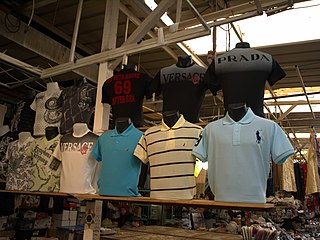
Authentication is the act of proving an assertion, such as the identity of a computer system user. In contrast with identification, the act of indicating a person or thing's identity, authentication is the process of verifying that identity. It might involve validating personal identity documents, verifying the authenticity of a website with a digital certificate, determining the age of an artifact by carbon dating, or ensuring that a product or document is not counterfeit.

To counterfeit means to imitate something authentic, with the intent to steal, destroy, or replace the original, for use in illegal transactions, or otherwise to deceive individuals into believing that the fake is of equal or greater value than the real thing. Counterfeit products are fakes or unauthorized replicas of the real product. Counterfeit products are often produced with the intent to take advantage of the superior value of the imitated product. The word counterfeit frequently describes both the forgeries of currency and documents as well as the imitations of items such as clothing, handbags, shoes, pharmaceuticals, automobile parts, unapproved aircraft parts, watches, electronics and electronic parts, software, works of art, toys, and movies.

A QR code is a type of two-dimensional matrix barcode, invented in 1994, by Japanese company Denso Wave for labelling automobile parts. A QR code consists of black squares arranged in a square grid on a white background, including some fiducial markers, which can be read by an imaging device, such as a camera, and processed using Reed–Solomon error correction until the image can be appropriately interpreted. The required data are then extracted from patterns that are present in both the horizontal and the vertical components of the QR image.
Intellectual property rights (IPRs) have been acknowledged and protected in China since 1980. China has acceded to the major international conventions on protection of rights to intellectual property. Domestically, protection of intellectual property law has also been established by government legislation, administrative regulations, and decrees in the areas of trademark, copyright, and patent.
A parallel import is a non-counterfeit product imported from another country without the permission of the intellectual property owner. Parallel imports are often referred to as grey product and are implicated in issues of international trade, and intellectual property.

Brand piracy is the act of naming a product in a manner which can result in confusion with other better known brands. According to author Robert Tönnis The term brand piracy is unauthorized usage of protected brand names, labels, designs or description of trade. Annika Kristin states "brand Piracy is considered to be the premeditated use of registered trademark, its name, its tradename or the packaging and presentation of its products". It is a major loss to MNEs around the world as it causes a loss of revenue and image of the brand.

An intellectual property (IP) infringement is the infringement or violation of an intellectual property right. There are several types of intellectual property rights, such as copyrights, patents, trademarks, industrial designs, and trade secrets. Therefore, an intellectual property infringement may for instance be one of the following:
The Prioritizing Resources and Organization for Intellectual Property Act of 2008 is a United States law that increases both civil and criminal penalties for trademark, patent and copyright infringement. The law also establishes a new executive branch office, the Office of the United States Intellectual Property Enforcement Representative (USIPER).

A trademark is a type of intellectual property consisting of a recognizable sign, design, or expression that identifies a product or service from a particular source and distinguishes it from others. A trademark owner can be an individual, business organization, or any legal entity. A trademark may be located on a package, a label, a voucher, or on the product itself. Trademarks used to identify services are sometimes called service marks.
Counterfeit consumer goods—or counterfeit, fraudulent, and suspect items (CFSI)—are goods, often of inferior quality, made or sold under another's brand name without the brand owner's authorization. The colloquial terms knockoff or dupe (duplicate) are often used interchangeably with counterfeit, although their legal meanings are not identical.

The National Intellectual Property Rights Coordination Center (NIPRCC) is a U.S. government center overseen by U.S. Immigration and Customs Enforcement, a component of the U.S. Department of Homeland Security. The NIPRCC coordinates the U.S. government's enforcement of intellectual property laws.

Trademark infringement is a violation of the exclusive rights attached to a trademark without the authorization of the trademark owner or any licensees. Infringement may occur when one party, the "infringer", uses a trademark which is identical or confusingly similar to a trademark owned by another party, especially in relation to products or services which are identical or similar to the products or services which the registration covers. An owner of a trademark may commence civil legal proceedings against a party which infringes its registered trademark. In the United States, the Trademark Counterfeiting Act of 1984 criminalized the intentional trade in counterfeit goods and services.

ISO/TC 292 Security and resilience is a technical committee of the International Organization for Standardization formed in 2015 to develop standards in the area of security and resilience.
ISO 22300:2021, Security and resilience – Vocabulary, is an international standard developed by ISO/TC 292 Security and resilience. This document defines terms used in security and resilience standards and includes 360 terms and definitions. This edition was published in the beginning of 2021 and replaces the second edition from 2018.
ISO 22382:2018 Security and resilience – Authenticity, integrity and trust for products and documents – Guidelines for the content, security and issuance of excise tax stamps, is an international standard developed by ISO/TC 292 Security and resilience and published by the International Organization for Standardization in 2018.
ISO 22382 is a guidance document that provides various of recommendations for the content, security, issuance and examination of physical tax stamps. The purpose of the standard is to avoid counterfeited products and ensure that the required taxes have been paid for, for example on items as tobacco and alcohol. The recommendations includes:
A copy detection pattern (CDP) or graphical code is a small random or pseudo-random digital image which is printed on documents, labels or products for counterfeit detection. Authentication is made by scanning the printed CDP using an image scanner or mobile phone camera. It is possible to store additional product-specific data into the CDP that will be decoded during the scanning process. A CDP can also be inserted into a 2D barcode to facilitate smartphone authentication and to connect with traceability data.

Scantrust is a Swiss company that provides an Internet of things platform for identifying products on the internet.

Justin Picard is a Swiss-Canadian engineer and entrepreneur who currently serves as the chief technology officer of Scantrust, a company he co-founded in 2013. He is the inventor of the copy detection pattern (CDP), a digital authentication technology for detecting product and document counterfeiting.
ISO 22380:2018 Security and resilience – Authenticity, integrity and trust for products and documents – General principles for product fraud risk and countermeasures, is an international standard developed by ISO/TC 292 Security and resilience and published by the International Organization for Standardization in 2018.
ISO 22380 is a guidance document that provides principles on how to identify the risks related to various types of product fraud and product fraudsters. The included guidance can be used by any type of organization in order to establish strategic, countermeasures to prevent or reduce any harm from fraudulent attacks.
ISO 22381:2018 Security and resilience – Authenticity, integrity and trust for products and documents – Guidelines for establishing interoperability among object identification systems to deter counterfeiting and illicit trade, is an international standard developed by ISO/TC 292 Security and resilience and published by the International Organization for Standardization in 2018. ISO 22381 is a guidance document that provides various of recommendations for establishing interoperability among independently functioning product identification and related authentication systems, as described in ISO 16678.










